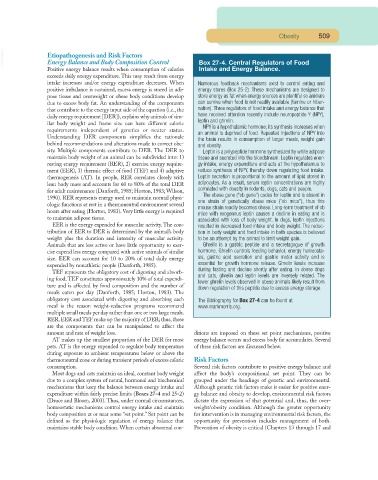Page 493 - Small Animal Clinical Nutrition 5th Edition
P. 493
Obesity 509
VetBooks.ir Etiopathogenesis and Risk Factors Box 27-4. Central Regulators of Food
Energy Balance and Body Composition Control
Positive energy balance results when consumption of calories Intake and Energy Balance.
exceeds daily energy expenditure. This may result from energy
intake increases and/or energy expenditure decreases. When Numerous feedback mechanisms exist to control eating and
positive imbalance is sustained, excess energy is stored in adi- energy stores (Box 25-2). These mechanisms are designed to
pose tissue and overweight or obese body conditions develop store energy as fat when energy sources are plentiful so animals
due to excess body fat. An understanding of the components can survive when food is not readily available (famine or hiber-
that contribute to the energy input side of the equation (i.e., the nation). Three regulators of food intake and energy balance that
have received attention recently include neuropeptide Y (NPY),
daily energy requirement [DER]),explains why animals of sim-
leptin and ghrelin.
ilar body weight and frame size can have different caloric
NPY is a hypothalamic hormone; its synthesis increases when
requirements independent of genetics or neuter status.
an animal is deprived of food. Repeated injections of NPY into
Understanding DER components simplifies the rationale
the brain results in consumption of larger meals, weight gain
behind recommendations and alterations made to correct obe- and obesity.
sity. Multiple components contribute to DER. The DER to Leptin is a polypeptide hormone synthesized by white adipose
maintain body weight of an animal can be subdivided into: 1) tissue and secreted into the bloodstream. Leptin regulates ener-
resting energy requirement (RER), 2) exercise energy require- gy intake, energy expenditure and acts at the hypothalamus to
ment (EER), 3) thermic effect of food (TEF) and 4) adaptive reduce synthesis of NPY, thereby down regulating food intake.
thermogenesis (AT). In people, RER correlates closely with Leptin secretion is proportional to the amount of lipid stored in
lean body mass and accounts for 60 to 80% of the total DER adipocytes. As a result, serum leptin concentrations are highly
correlated with obesity in rodents, dogs, cats and people.
for adult maintenance (Danforth, 1985; Horton, 1983; Wilson,
The obese gene (“ob gene”) codes for leptin and is absent in
1990). RER represents energy used to maintain normal physi-
one strain of genetically obese mice (“ob mice”), thus this
ologic functions at rest in a thermoneutral environment several
mouse strain readily becomes obese. Long-term treatment of ob
hours after eating (Horton, 1983). Very little energy is required
mice with exogenous leptin causes a decline in eating and is
to maintain adipose tissue. associated with loss of body weight. In dogs, leptin injections
EER is the energy expended for muscular activity. The con- resulted in decreased food intake and body weight. The reduc-
tribution of EER to DER is determined by the animal’s body tion in body weight and food intake in both species is believed
weight plus the duration and intensity of muscular activity. to be an attempt by the animal to limit weight gain.
Animals that are less active or have little opportunity to exer- Ghrelin is a gastric peptide and a secretagogue of growth
cise expend less energy compared with active animals of similar hormone. Ghrelin controls feeding behavior, energy homeosta-
size. EER can account for 10 to 20% of total daily energy sis, gastric acid secretion and gastric motor activity and is
essential for growth hormone release. Ghrelin levels increase
expended by nonathletic people (Danforth, 1985).
during fasting and decline shortly after eating. In obese dogs
TEF represents the obligatory cost of digesting and absorb-
and cats, ghrelin and leptin levels are inversely related. The
ing food.TEF constitutes approximately 10% of total expendi-
lower ghrelin levels observed in obese animals likely result from
ture and is affected by food composition and the number of
down regulation of this peptide due to excess energy storage.
meals eaten per day (Danforth, 1985; Horton, 1983). The
obligatory cost associated with digesting and absorbing each The Bibliography for Box 27-4 can be found at
meal is the reason weight-reduction programs recommend www.markmorris.org.
multiple small meals per day rather than one or two large meals.
RER,EER and TEF make up the majority of DER; thus,these
are the components that can be manipulated to affect the
amount and rate of weight loss. ditions are imposed on these set point mechanisms, positive
AT makes up the smallest proportion of the DER for most energy balance occurs and excess body fat accumulates. Several
pets. AT is the energy expended to regulate body temperature of these risk factors are discussed below.
during exposure to ambient temperatures below or above the
thermoneutral zone or during transient periods of excess caloric Risk Factors
consumption. Several risk factors contribute to positive energy balance and
Most dogs and cats maintain an ideal, constant body weight affect the body’s compositional set point. They can be
due to a complex system of neural, hormonal and biochemical grouped under the headings of genetic and environmental.
mechanisms that keep the balance between energy intake and Although genetic risk factors make it easier for positive ener-
expenditure within fairly precise limits (Boxes 27-4 and 25-2) gy balance and obesity to develop, environmental risk factors
(Druce and Bloom, 2003). Thus, under normal circumstances, dictate the expression of that potential and, thus, the over-
homeostatic mechanisms control energy intake and maintain weight/obesity condition. Although the greater opportunity
body composition at or near some “set point.” Set point can be for intervention is in managing environmental risk factors, the
defined as the physiologic regulation of energy balance that opportunity for prevention includes management of both.
maintains stable body condition. When certain abnormal con- Prevention of obesity is critical (Chapters 13 through 17 and

